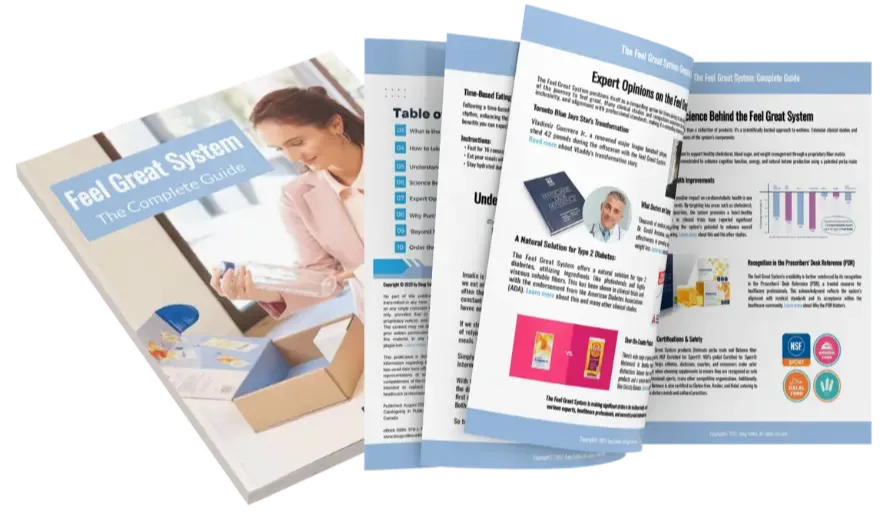11 Warning Signs of Type 2 Diabetes You Can't Ignore: How to Control Blood Sugar
Oct 30, 2023
Type 2 diabetes is more than a buzzword or a hereditary condition—it's a wake-up call sounding across the globe, impacting millions.
When the body fails to regulate blood sugar levels, a cascade of severe health issues can follow. Understanding its symptoms, complications, and mastering its management can be life-altering.
In this blog article we navigate through the early warning signs, delve into its health complications, and shed light on medical interventions. We'll also highlight how the Unicity Balance fiber matrix is a science-based solution to glucose control helping you look better, feel great and improve your quality of life.
Recognizing the Signs of Type 2 Diabetes
Type 2 diabetes is a preventable, reversible chronic disease that, while genetics can play a role, is caused by nutrition and lifestyle factors.
These 11 symptoms are among the key signs pointing to uncontrolled type 2 diabetes. Catching these signs early can make a world of difference in your health journey.
| Diabetic Symptom | Description |
|---|---|
| High Blood Glucose | The clearest indicator that diabetes needs your attention is elevated blood glucose levels. |
| Frequent Infections | High sugar levels can make you more prone to infections. It's important to consult a healthcare professional if you're facing increased frequency of infections or slower healing. |
| Increased Urination | Also known as polyuria, frequent urination is common to both type 1 and type 2 diabetes. This happens when you urinate more than 3 liters a day as your body tries to expel excess glucose. |
| Thirst Spike | Extreme thirst, or polydipsia, can result from high blood glucose, leading to dehydration despite drinking more fluids. |
| Diabetic Ketoacidosis | Dehydration can contribute to this life-threatening condition. When your body lacks glucose for energy, it starts breaking down fats, leading to acidic blood. |
| Ketones Accumulation | These are byproducts of the fat breakdown process, and their build-up in the blood can be hazardous. Symptoms include dizziness, nausea, and even a diabetic coma. |
| Appetite without Weight Gain | Despite high glucose levels, your cells may lack energy due to ineffective insulin usage or production. |
| Weight Loss | The inability to utilize glucose effectively can result in weight loss, depending on your eating habits and glucose usage. |
| Kidney Issues | Persistent high glucose levels can harm your blood vessels, including those in your kidneys, leading to kidney disease over time. |
| Cardiovascular Symptoms | High blood pressure, obesity, and cholesterol issues can increase heart disease risk. This is the most dangerous and potentially fatal complication of diabetes. |
| Numbness and Tingling | Chronic high glucose can cause nerve damage, specifically affecting sensation in your hands and feet. |
The Serious Consequences of Uncontrolled Type 2 Diabetes
Overlooking the symptoms of diabetes isn't just a minor oversight—it's a direct risk to your well-being. Unmanaged type 2 diabetes isn't simply an inconvenience; it can culminate in severe health setbacks including heart complications, kidney deterioration, and significant nerve impairment.
| Condition | Description |
|---|---|
| Cardiovascular Disease | Elevated blood sugar levels can harm the vessels and nerves that fuel your heart, upping your chances of heart attacks and strokes. |
| Neuropathy | Excessive sugar in the bloodstream can lead to nerve damage, or neuropathy, which results in sensations like numbness and tingling in various parts of the body. |
| Kidney Damage | Also known as nephropathy, this condition can escalate into kidney failure. High sugar levels can impair the tiny vessels in your kidneys, making them less effective at filtering waste. |
| Eye Complications | The risk for eye issues such as cataracts and glaucoma spikes with type 2 diabetes. Sugar-induced damage to retinal blood vessels can cause diabetic retinopathy, a major cause of vision loss. |
| Foot Concerns | Poor circulation and nerve damage in the feet can spiral into severe infections and, in extreme cases, amputation. |
Conventional Type 2 Diabetes Treatments and Their Limitations
While some individuals with type 2 diabetes can achieve nearly normal blood sugar levels through diet and exercise alone, many require additional support through diabetes medication or insulin therapy.
The pharmaceutical industry and the medical profession in general, have predominantly focused on managing blood glucose with medications, which often fall short in providing long-term solutions. What's often overlooked is the potential of dietary fiber as a science-based approach to maintaining healthy blood sugar levels.
Understanding Fiber's Role in Blood Sugar Management
Dietary fiber, especially the soluble type, has emerged as a significant player in managing blood sugar.
Soluble fiber dissolves in water, creating a gel-like substance that can decelerate sugar absorption in your bloodstream. Foods rich in soluble fiber include oats, barley, and beans. On the other hand, insoluble fiber, found in whole wheat, wheat bran, and nuts, doesn't dissolve in water but aids in bowel regularity.
By reducing rapid sugar absorption and enhancing insulin sensitivity, fiber offers dual benefits in preventing post-meal sugar spikes and increasing the body's responsiveness to insulin. Additionally, it helps in curbing appetite, which indirectly aids in blood sugar control.
Achieving Your Daily Fiber Goals for Blood Sugar Control
While we know the perks of fiber, many of us fall short of the recommended intake of 25-30 grams daily. However, we can boost our fiber intake if we work towards five servings of fiber-rich fruits and veggies every day. Make the switch to whole grain versions of bread, pasta, and rice. Legumes like beans, lentils, and chickpeas are also excellent choices as they are powerhouses of fiber and protein.
And remember, if you're transitioning to a fiber-rich diet, it's best to start slow to give your digestive system time to adjust. Want to make it even easier?
In addition to the dietary changes, the Feel Great System is designed to help you seamlessly increase your fiber intake and is scientifically-proven to balance blood glucose.
Unicity Balance: The Game-Changer for Healthy Blood Sugar
Unicity Balance is the clinically proven natural fiber supplement formulated to encourage weight loss, increase energy, and to better control your blood chemistry. There is a wide range of options to increase dietary fiber, from Metamucil to Benefiber. However, there are notable distinctions between those over-the-counter (OTC) fiber products and Unicity Balance fiber matrix, as we will explore in this article.
Many healthcare providers have discovered the power of Unicity Balance as the alternative to drugs like Metformin and Glyburide, the first-line drug treatment and the current standard of care for type 2 diabetes, as well as Statin medications for cholesterol management.
Using Unicity Balance is simple, just dissolve the contents of one packet into 8 to 10 fl. oz. of liquid (water or juice), stir or shake vigorously and drink immediately. Take it 10 to 15 minutes before your meal.
By slowing the rate your body turns food into glucose, Unicity Balance effectively limits the amount of insulin needed. This means instead of turning all that glucose in your body into more fat, your body will efficiently use that glucose for energy. In addition, between meals your body will enter a fat-burning state by generating glucagon, which works to raise low blood sugar levels by breaking down current fat stores.
Managing type 2 diabetes goes beyond just steering clear of sugary delights. It's about adopting practices that address total lifestyle principle's. Interested in going deeper into the world of efficient diabetes management with the Feel Great System and understanding how you can benefit from taking Unicity Balance fiber matrix?
Your health transformative journey starts here! Grab your guide today! Start with downloading the Feel Great System eBook now!
Get the Feel Great System eBook PDF Guide sent to you immediately!
Feel Better Than You Have In Years!




